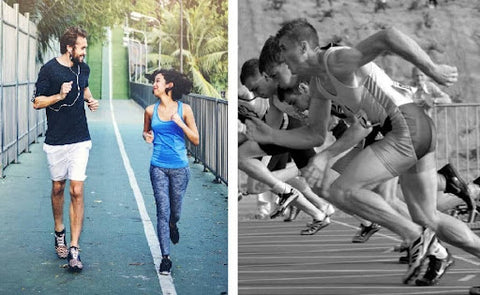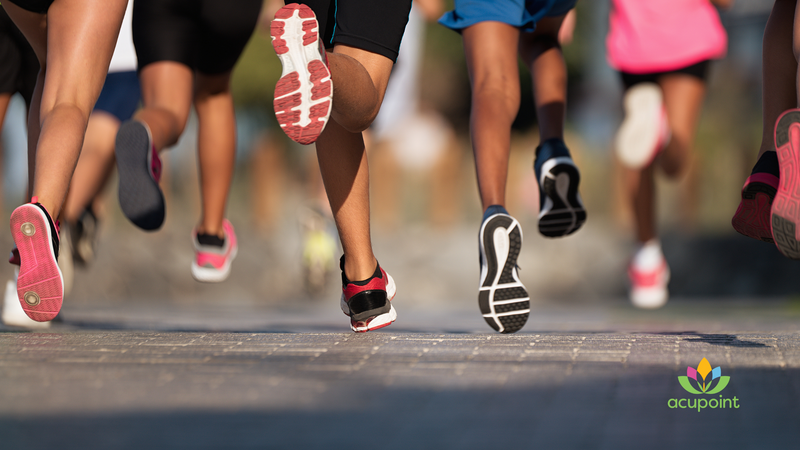Running is becoming a more popular sport in the fitness community. It doesn't require much in the way of specific equipment, and it's suitable for people of various ages and backgrounds. All you need is your running shoes and a flat surface to run. While some people run for pure enjoyment, others use it as a means of staying in shape and losing weight.
Myth: You Can’t Lose Weight by Running

Credit: POPSUGAR
Calories in-calories out is one of the most basic weight-loss guidelines. In order to lose weight, you need to burn more calories over the course of a week than you ingest. You can change this equation by burning more calories, eating fewer calories, or doing a mix of the two.
Running (and walking) both burn approximately 100 calories each mile, however, this number will be substantially higher when you first begin and when you have a significant amount of excess weight. You'd have to run 25–35 miles each week to burn the equivalent of an extra pound per week only from running.
It's understandable why this might be difficult. Furthermore, it can be easy to take back many of those calories if you even subconsciously tell yourself that you can eat a bit more because you've been running. These simple reasons explain why all of the advice cautions against relying entirely on running to lose weight. So it can make sense why a lot of people may think that running doesn't help to shed excess pounds.
What Are Calories and How Do They Work?

Credit: Stuart Minzey/Getty Images
When you eat or drink something, it provides you with a specific amount of energy. Calories are the name for these units. Your daily caloric expenditure, or how many calories you burn each day, is separated into three elements that are all equally important:
Expenditure of Activity Energy. These are the calories you burn when you're moving about. It makes no difference whether you're exercising or not. Driving, changing your bed, and taking a shower, among other tasks, all burn calories.
Energy Expenditure While at Rest. These are the calories your body expends while performing its most basic processes. While you breathe or your blood flows within your body, you burn calories.
Thermic Effect of Food. These are the calories you expend when chewing, digesting, and assimilating your food.
Running consumes more energy than milder cardiovascular activities such as walking. According to studies, the more intensive and exercise is, the more activity energy is expended. However, physical variables such as age, gender, height, and body mass may influence the outcome.
Types of Runs

Credit: HiConsumption
1) Run to Recover
A recovery run is a short run that is done at a slow pace. Recovery runs allow a runner to add some distance to their training without sacrificing performance in the harder, more crucial workouts that come before and after them. After rigorous training, such as an interval run, recovery runs are best done as the next run. Run your recovery runs as slowly as you need to feel comfortable, even if you're still tired from your last run.
2) Base Run
A base run is a short to moderate-length run that is completed at the runner's natural pace. While individual base runs aren't designed to be difficult, they should be done regularly in order to see significant gains in aerobic capacity, endurance, and running economy. The majority of your weekly training miles will be made up of base runs.
3) Long Run
A long run is a base run that lasts long enough for a runner to become moderately to severely exhausted. A lengthy run's purpose is to build raw endurance. Of course, the distance or time required to produce this impact is determined by your existing level of endurance.
4) Progression Run
A progression run begins at a runner's natural pace and progresses to a quicker pace at the end. These runs are supposed to be challenging, but not as difficult as base runs or most interval runs. Because they're medium-intensity workouts, they require less recuperation time than more strenuous workouts.
5) Hill Repeats
Hill repeats are short bursts of strenuous uphill running that are done several times. They boost aerobic power, resistance to high-intensity fatigue, pain tolerance, and run-specific strength. Slope repeats should be run on a hill with a consistent, moderate gradient of 4 to 6 percent.
6) Intervals
Interval workouts are made up of brief bursts of fast running followed by gradual jogging or standing recovery periods. This form of running allows a runner to fit more swift-running into a single exercise than a single continuous fast exertion until exhaustion.
Afterburn Effect

Credit: Women’s Health
Any sort of exercise will help you lose weight if you do it on a regular basis, but only a few types of exercise will continue to burn calories after you've finished working out.
Hill repeats and interval runs, for example, can burn calories for up to 48 hours after you finish your workout.
These exercises use a lot of muscles and require a lot of energy to recover from. In the fitness community, this is known as the "afterburn effect." The "afterburn effect," according to some studies, can help you burn significantly more calories over time.
Running for Weight Loss: Things To Keep in Mind

Credit: Health and Wellbeing
Here's all you need to know about running for weight loss:
1) Keep Your Diet In Check
Running has a lot of advantages, including weight reduction, but it shouldn't be used as an excuse to ignore your diet, especially if you're attempting to lose weight.
The majority of people underestimate how many calories they burn while running. You burn roughly 100 calories every mile, as a rough estimate. Running two or three miles will burn roughly 200 to 300 calories, which is a good exercise.
If you want to lose weight, you'll need to generate a calorie deficit overall. Monitor your caloric intake and follow a healthy diet, this will aid in weight loss.
2) Push Yourself
Athletes are often tweaking their training regimens and race-day preparations, but you don't have to go crazy if you're just getting started. If you prefer sprints, which burn more calories per minute, go for it; if you prefer walking or slower jogging, you'll simply need to spend more time burning those calories.
3) Don’t Miss Out on Strength Training and High-Intensity Interval Training
Weight training and resistance training is beneficial for a number of reasons. For one, it makes you a stronger runner and lowers your chance of injury. Running is only difficult on the joints if you lack the necessary muscle to sustain them. Lifting weights, on the other hand, will assist you in losing weight. You'll burn more calories at rest if you have more lean muscle mass. That's accurate, if you have greater muscle, you'll burn more calories even if you're just sitting around. A high-intensity exercise will also help you shed fat quickly.
4) Keep Yourself Hydrated
It's not rare for people to misinterpret hunger with thirst. Start with a large glass of water when you get home from your exercise. This rehydrates you and takes up space which will help in cutting calories.
Jogging vs. Running

Credit: Alpha Male
Running and jogging differ in terms of intensity. Running is faster than jogging. Running, as opposed to jogging, necessitates a higher level of general fitness.
Running and jogging are both aerobic activities. Both activities help to reach your goal weight and shed those unwanted pounds.
Beginners Guide to Running and Jogging

Credit: News18
Some general pointers for newcomers:
- Begin by going for a quick stroll. Set aside 30 minutes for each session. Attempt to extend your jogging time and alternate between walking and jogging during each activity.
- Make sure you warm up completely before going running. When you arrive home, relax your body by doing some simple stretches.
- Make a route plan. To lessen the chance of damage, pick flat, grassy places rather than hard or loose (such as sandy) terrain.
- Running near roads should be avoided.
- Wear cotton apparel that is loose.
- Apply sunscreen with an SPF of 50+ to any exposed skin.
- Purchase a suitable pair of shoes.
Choosing a Pair of Running or Jogging Shoes

Credit: Runner’s World
When it comes to running shoes, there are a few things to think about:
- Wear your new sneakers instead of your old ones. Injuries are frequently caused by ill-fitting shoes.
- The running shoe should be able to bend easily, be comfortable, and contain a shock-absorbing heel wedge.
- It should not be overly tight. As your foot collides with the ground, it will splay.
- Wear the socks you'll be running in when you go shoe shopping.
How Running Can Help You Live a Longer, Healthier Life

Credit: Eat. Lose. Gain
1) Improved Cardiovascular System:
Running, often known as jogging, is one of the most effective aerobic exercises available. Running for at least 10 minutes per day can drastically decrease your chance of heart disease.
2) Lowered Heart Rate:
It also lowers your resting heart rate, which is the number of times your heart beats per minute when you're not doing anything. If your heartbeat is slower, it will be more efficient.
3) More Restful Slumber:
A good night's sleep is critical to your overall health. Your body cures itself as you sleep, which is why you feel refreshed when you wake up.
4) You Experience Fewer Colds:
Running for 30 minutes can assist your immune system kick in and help you feel better if you're feeling a little off. You can reduce your risk of upper respiratory infections by 43 percent if you practice cardiovascular exercises like running at least 5 days a week according to scientific evidence.
5) Better Energy and Mood:
Many people run to make themselves feel better. The running routine improves your mood, focus, and overall life quality.

Summary
To summarize, running is one of the best workouts to meet your fitness goals and weight loss goals when coupled with other exercises. Make sure you have a healthy diet and you can contact a registered dietitian if you find it difficult to adjust to your new dietary changes. Losing weight requires commitment and healthy habits. It could be difficult the first couple of times when you start running, but soon you will be ready to run a half marathon and that calorie burn will feel so good. So what are you waiting for? Grab your running shoes today!










